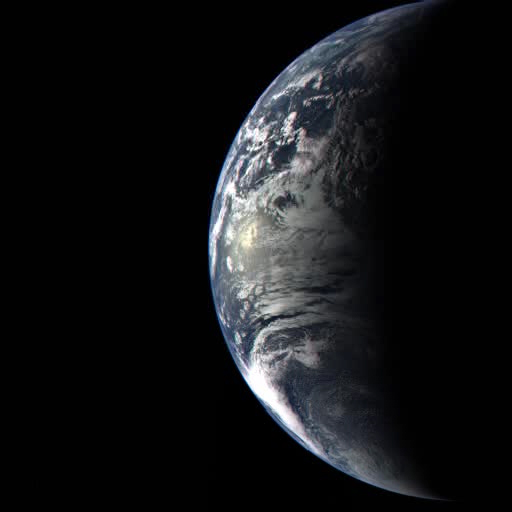Press Release
Movie Headlines MESSENGER Earth Flyby Gallery
Fri, 08/26/2005 - 15:55
The pictures from MESSENGER's Aug. 2 flyby of Earth are in — and they are spectacular! The collection includes "natural" color and infrared views of North and South America; a peek at the Galapagos Islands through a break in the clouds; and a movie of the rotating Earth, taken as MESSENGER sped away from its home planet.
The close flyby of the Earth and Moon allowed the Mercury-bound MESSENGER spacecraft to give its two cameras, known as the Mercury Dual Imaging System (MDIS), a thorough workout. The images were planned to enable scientists to understand fully how the cameras are operating in flight in comparison with test results obtained in the laboratory before launch. Images were taken in full color and at different resolutions, and the cameras passed their tests with flying colors.
Not only are these images useful for carefully calibrating the imaging system in preparation for the spacecraft's Mercury encounters, but they have also shown a unique view of the Earth. Clear skies over much of South America allow features such as the Amazon, the Andes and Lake Titicaca to be discerned, as well as huge swaths of rain forest.
One of the highlights of the returned images is a movie, comprised of hundreds of color images taken over a 24-hour period, showing one full rotation of the Earth.
"We are thrilled with the images from the flyby, which have demonstrated that MDIS is performing exactly as planned," said Louise Prockter, MESSENGER's deputy instrument scientist, who planned the observations. "The movie has brought home to me the contrast between our beautiful ocean-covered, cloud-wreathed Earth and our destination planet Mercury — a world on which lead would melt on the daytime surface near the equator but one on which ice may be stable for eons on the shadowed floors of polar craters. We have much to learn about a planet that, although one of our nearest neighbors in the solar system, differs profoundly from Earth in bulk composition and geologic history. The tests we carried out during the Earth flyby show that our cameras are well up to the task of unlocking many of Mercury's secrets."
One of seven instruments in MESSENGER's science payload, the multispectral MDIS has wide- and narrow-angle imagers, both based on charge-coupled devices (CCDs) found in common digital cameras.
During a 4.9-billion mile (7.9-billion kilometer) journey that includes 15 trips around the Sun, MESSENGER will fly past Earth once, Venus twice and Mercury three times before easing into orbit around its target planet. The Earth flyby and the Venus flybys, in October 2006 and June 2007, will use the pull of the planets' gravity to guide MESSENGER toward Mercury's orbit. The Mercury flybys in January 2008, October 2008 and September 2009 help MESSENGER match the planet's speed and location for an orbit insertion maneuver in March 2011. The flybys also allow the spacecraft to gather data critical to planning a yearlong orbit phase.
MESSENGER, short for MErcury Surface, Space ENvironment, GEochemistry, and Ranging, is the seventh mission in NASA's Discovery Program of lower cost, scientifically focused exploration projects. Dr. Sean C. Solomon, of the Carnegie Institution of Washington, leads the mission as principal investigator. APL manages the mission for NASA, built MESSENGER and operates the spacecraft. For more information, visit the MESSENGER Web site at messenger.jhuapl.edu.
